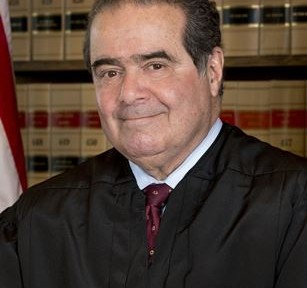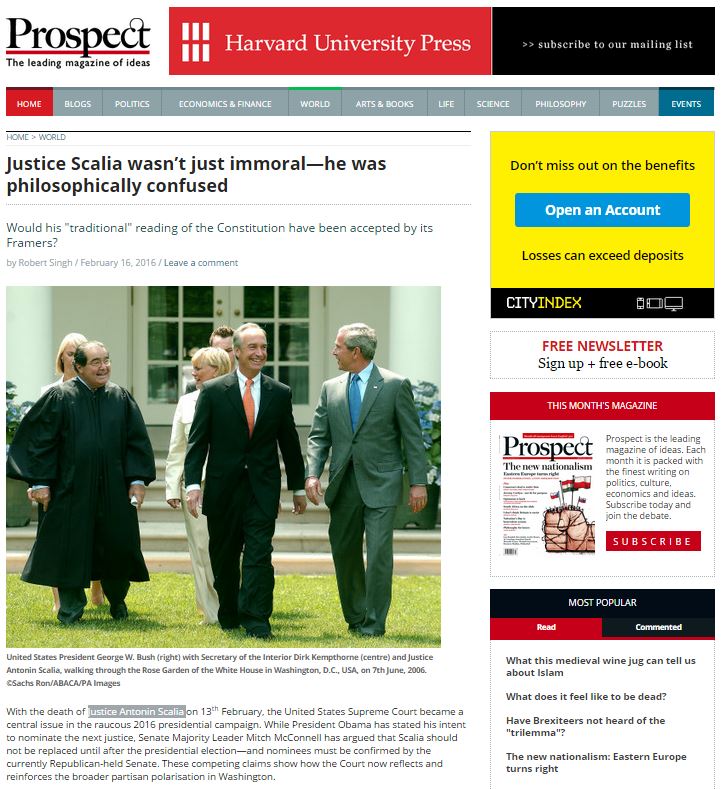This post was contributed by Rob Singh, Professor of Politics at Birkbeck. Prof Singh’s new book, ‘After Obama: Renewing American Leadership, Restoring Global Order’ will be published by Cambridge University Press in May.
This aticle was originally published in Prospect on 16 February.
With the death of Justice Antonin Scalia on 13th February, the United States Supreme Court became a central issue in the raucous 2016 presidential campaign. While President Obama has stated his intent to nominate the next justice, Senate Majority Leader Mitch McConnell has argued that Scalia should not be replaced until after the presidential election — and nominees must be confirmed by the currently Republican-held Senate. These competing claims show how the Court now reflects and reinforces the broader partisan polarisation in Washington.

Justice Antonin Scalia (By Steve Petteway, photographer, Supreme Court of the United States[1] (See [2]) [Public domain], via Wikimedia Commons)
A man of acerbic wit and often scathing venom, Scalia developed an approach to constitutional interpretation—originalism—that many found coherent and compelling (a whole book, Scalia Dissents, was even dedicated to his disagreements with prevailing opinion). In a democracy, how can a Court legitimately strike down the laws passed by the Congress and signed by the president? Originalism offered a simple solution: rather than consider what the writers of laws, or of particular constitutional clauses, intended the law to mean, judges should instead interpret these in terms of how the text was commonly understood at the time it was adopted. That adherence to the values of others seemed to limit the dangers of judges writing their own views into law. It had the happily convenient benefit, to Scalia, of also yielding reliably conservative policy outcomes. But three problems plagued the path Scalia paved, which he never convincingly resolved.
First, the practical outcomes of Scalia’s philosophy are widely regarded as repugnant to contemporary moral values. Take Maryland v Craig (1990), where the Court upheld a state law allowing a victim of child sex abuse to testify over CCTV rather than in court, in the presence of her abuser. Scalia dissented, arguing that the Sixth Amendment provides that in “all criminal prosecutions the accused shall enjoy the right… to be confronted with the witnesses against him.”
The only things that had changed since 1791, he argued, were society’s “so-called sensitivity to psychic trauma” and the judgment of where the proper balance lay between assuring conviction of child abusers and acquittal of those falsely accused of abuse. At the same time, in supporting states’ rights to enact statutes rooted in “moral disapproval,” Scalia opposed striking down laws criminalising gay sex in 2003. Relying on “tradition” and popular sentiment to thwart progress, he selectively transformed the Bill of Rights from a safeguard against majoritarianism into another expression of it.
But beyond specific rulings was a second, broader problem. Central to Scalia’s judicial philosophy was an inherent contradiction: would the original framers of the Constitution whom he so venerated have prescribed an originalist approach? Compelling evidence suggests otherwise. Not only is the language of the document notoriously ambiguous and vague, deliberately open to competing and evolving interpretations, but the Framers expressly rejected freezing the fledgling republic in the conditions of 1787. Iconic figures such as Thomas Jefferson even expected new generations to rewrite the Constitution anew.
Thirdly, in decisions such as that made in court case The District of Columbia v. Dick Heller (2008) (which was presided over by the Supreme Court of the United States, and thus Scalia) the Court hardly exemplified a conservative role; for the first time in American history an individualist reading of the Second Amendment was announced. It was ruled that an individual is entitled to carry a firearm for private purposes, such as self-defence, and that the Amendment doesn’t just apply to the rights of groups such as militias. The result of this ruling was a litigation bonanza centred on exactly what gun regulations offend a citizen’s right to own firearms. But if the US survived more than two centuries without the 2nd Amendment ever conferring such a right, when did this change, and why?
Originalists used to criticise the Court’s progressive rulings of the 1960s and 1970s, when the liberal Justices exercised “raw judicial power” by “inventing” new constitutional rights that weren’t explicitly in the Constitution. Now, the same charge can be levelled at the conservatives, whose recent embrace of judicial activism often appears less philosophical rationale than political rationalisation.
To be fair, Scalia did frequently abide by his own strictures to act as a judge rather than a legislator, not least on First Amendment cases such as flag desecration, where his reading of free expression trumped his affront at unpatriotic acts such as burning the Stars and Stripes. But it is difficult to disassociate his embrace of originalism from his finding in its cold but confused logic a way to oppose every progressive advance from reproductive rights to affirmative action.
George W Bush declined the opportunity to elevate Scalia to the Chief Justiceship in 2005, but Republican presidential candidates have already solemnly avowed to appoint “another Scalia” to the Court, should they be sworn into office in 2017. The chances of that are increasingly slim. With the Court’s future direction now a key issue in the presidential election, several vulnerable Republican Senators facing uphill battles for re-election in swing states such as Wisconsin and Illinois, and the Grand Old Party likely to seem nakedly partisan in obstructing a new Obama judicial nominee from even coming to a vote, Scalia seems likely to remain a magnet for controversy in death as well as life.
It would be mildly ironic if Scalia’s passing, and controversial legacy, hamper the prospect of a more conservative direction in constitutional law by helping to energise the Democratic Party base and costing the GOP the White House and/or the Senate. And even more ironic that the remainder of this year’s contentious argument over the Court will itself test the proposition of whether a Constitution designed in and for the 18th century is still fit for purpose in the 21st, or more resembles a noble piece of paper housed in the National Archives.
Find out more


